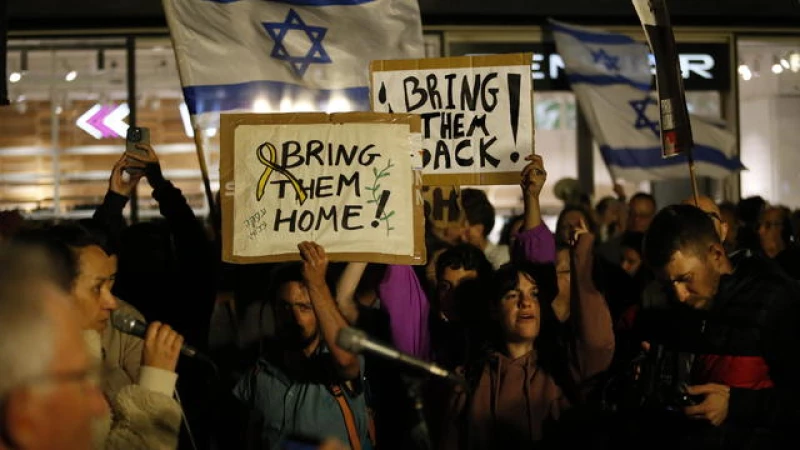Tel Aviv — Israeli Prime Minister Benjamin Netanyahu faced mounting pressure on Monday from various factions regarding his country's ongoing war against Hamas in the Gaza Strip. Members of Netanyahu's own far-right cabinet have threatened to withdraw support for his coalition government if he agrees to a cease-fire with Hamas. However, both the U.S. and many Israelis are urging him to negotiate a deal to bring back the remaining hostages from Gaza and end the destructive conflict in the Palestinian territory.
The push for a cease-fire gained momentum after the release of a recent Hamas propaganda video featuring two hostages, including Israeli-American Keith Seigel, who are still alive.
This week has seen a flurry of diplomatic efforts in the region, with Secretary of State Antony Blinken visiting in a final attempt to broker a cease-fire before a potential Israeli ground operation in the southern Gaza city of Rafah, where 1.4 million Palestinians are seeking refuge in dire conditions.
A Hamas delegation was set to provide their response on Monday to the latest proposal for a long-awaited truce and the release of hostages.
In a meeting with Gulf region counterparts in Saudi Arabia, Blinken emphasized the importance of a cease-fire to alleviate the humanitarian crisis in Gaza. He stated that civilians cannot wait for a cease-fire and urged Israel to take immediate action to support the needs of civilians.
Blinken acknowledged some progress in recent weeks, such as the opening of new border crossings and increased aid delivery to Gaza. However, he emphasized that more needs to be done, mentioning the upcoming opening of the U.S. maritime corridor.
President Biden has called on Israel to take specific and measurable steps to address humanitarian suffering, protect civilians, and ensure the safety of aid workers in Gaza. The ongoing conflict has resulted in the deaths of over 34,000 people, predominantly women and children, according to Gaza's Health Ministry.
While there has been an increase in aid entering Gaza, United Nations agencies warn that tens of thousands of individuals are at risk of famine in the territory. The current level of aid has not been sufficient to prevent this crisis.
The dilemma facing Netanyahu involves the decision on the fate of approximately 130 hostages, including five U.S. citizens who are believed to still be alive. The escalating pressure regarding the war's impact on Palestinian civilians is in conflict with his declared mission to eradicate Hamas. Netanyahu insists that a Rafah incursion is necessary to achieve this objective, citing the presence of Hamas combat units hiding in the city.
However, demands from the families of the remaining captives to negotiate a resolution have become more vocal and forceful. They have organized frequent large-scale protests on the streets of Israel, accusing Netanyahu of neglecting the hostages. These demonstrations have occasionally turned violent, resulting in clashes with law enforcement.
There is also mounting pressure for a cease-fire from various college campuses in the U.S., which are crucial allies and supporters of Israel, as well as from concurrent protests emerging on European university campuses. The anti-war protests have not gone unnoticed by displaced Palestinian students in Rafah, whose academic pursuits were abruptly interrupted on October 7.
"The solidarity shown towards us gives us a glimmer of hope, especially the support from American university students," expressed Renad Anaan, a student speaking to CBS News from a displaced persons camp. "I commend the American students who are protesting against Netanyahu's government and the U.S. government. Their actions are heartening, and I urge students worldwide to stand up against oppressive regimes," added Fida Afifi, whose studies in Gaza City were disrupted by the conflict.
Israel has made a concerted effort in recent days to show it's stepping up aid distribution in Gaza, and the IDF released video over the weekend showing the floating pier being built by the U.S. military just off envlave's Mediterranean coast. Officials have said it will be completed in early May, creating another new route for help to reach people who desperately need it.
There's hope that a cease-fire deal, or even progress toward one, could delay or even scuttle the plans for Netanyahu's promised invasion of Rafah. But in the meantime, the threat of ground warfare in the crowded city continues to hang over the students and the tens of thousands of other civilians sheltering in Rafah.
Much of the rest of Gaza lies in ruin — destruction on a scale that has left entire towns and cities uninhabitable.
Nowhere is really safe. Even in Rafah, the Israel Defense Forces carry out daily air and missile strikes. Monday morning, amid the renewed talk of a possible cease-fire, there were three new strikes on the city. At least five more children were among the dead, according to health officials in the Hamas-run territory.
Both humanitarian air drops and Israel's bombardment continued over the weekend, and Palestinians eking out survival in the tent city that's grown in and around Rafah never know whether planes flying above carry the threat of death, or the promise of life saving aid.







